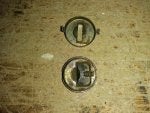Ignition Barrel Sticking - DIY Fix
Edit: See post 20 for instructions
===========================
Hi Guys,
The ignition barrel on my GSXR K1 1000 is starting to get a little 'rough' to insert the key into
I think this is down to the 'shield' on the barrel not closing fully and covering the barrel when the key is removed, thereby letting dirt get into the barrel
Is there anyway I can get the shield/cover working smoothly again to ensure the barrel is covered when the key is removed?

Edit: See post 20 for instructions
===========================
Hi Guys,
The ignition barrel on my GSXR K1 1000 is starting to get a little 'rough' to insert the key into
I think this is down to the 'shield' on the barrel not closing fully and covering the barrel when the key is removed, thereby letting dirt get into the barrel
Is there anyway I can get the shield/cover working smoothly again to ensure the barrel is covered when the key is removed?










